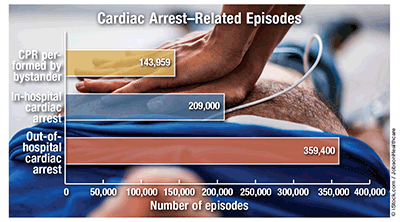US Pharm. 2016;41(2):16.
Annually, more than 350,000 Americans die from heart disease, of which number nearly one-half die suddenly from cardiac arrest (CA). In 2013, 72% more CAs occurred in the community setting than in the hospital. The Cardiac Arrest Registry to Enhance Survival (CARES) system quantifies data on hospital discharge and responses to CA in community settings. Every day, 1,000 people experience an out-of-hospital CA (OHCA) with an overall 10.8% chance of survival (5.4% chance of survival for the 26 children included in this number).

Bystander Response: The CARES categories “witnessed by bystander,” “found in ventricular fibrillation” (VF), and “received cardiopulmonary resuscitation [CPR] and/or automated external defibrillator [AED] applied by bystander” resulted in a survival rate that rose from 35% in 2010 to 36.1% in 2014. Of the nearly 45,500 OHCA patients who received resuscitation in public settings and survived, 61.1% were men with a median age of 65 years. The home or residence was the predominant site where 70% of CPR was provided, followed by public settings (19.5%) and nursing homes or assisted-living facilities (10.6%). Bystanders witnessed more OHCAs than did first responders (37.7% vs. 12.1%). When a bystander or first responder who witnessed a collapsed patient with pulseless ventricular tachycardia performed CPR before emergency medical services (EMS) personnel arrived, 65% more patients survived to hospital discharge. In children with OHCA whose VF was witnessed by a bystander, the survival rate was 26.7%, compared with the population-based overall rate of 31.7%.
EMS Response: Survival rates of OHCA assessed and treated by EMS are 5.4% and 4.4%, respectively. Each year, 424,000 people experience OHCA as assessed by EMS, and 60% are treated by EMS. Among EMS-treated OHCA cases, 23% have VF and therefore could respond well to AED treatment. The EMS and first responders performed CPR in 32.7% and 26.8% of OHCA episodes, respectively. The AED was used on 27.1% of OHCA patients prior to EMS arrival. Bystanders and first responders applied the AED in 18.2% and 81.7% of CA cases, respectively. Defibrillation was performed first by EMS personnel in 25.4% of cases, followed by first responders (6.1% of cases) and bystanders (1.6% of cases).
Importance of CPR: CPR performed after successful defibrillation may reinduce VF in up to 22% of CA cases. Patients who received bystander CPR had a higher survival rate than those treated by the EMS. Following protocols, the EMS pronounced 27.2% of patients dead after resuscitation efforts were terminated in the prehospital setting. Approximately 16.8% of patients were pronounced dead in the emergency department (ED), and 55.6% were resuscitated in the ED.
To comment on this article, contact rdavidson@uspharmacist.com.





